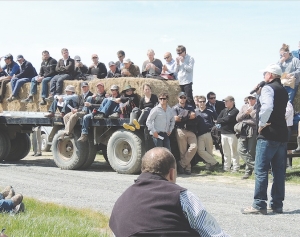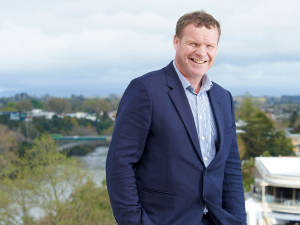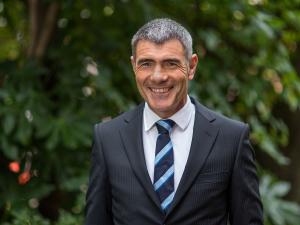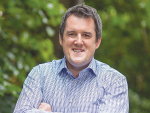Not only was the farming on view an exposé of cutting edge precision cropping that earned Craige and Roz Mackenzie the BFEA national title, as well as the region’s top accolade, but a howling norwester whipped off hats and forced trailers to corral so speakers could be heard.
But the show went on and as the day developed a dozen speakers divulged details on a diverse range of topics, from the high tech of tractors that steer themselves and ‘talk’ to the farm office, to the down to earth matters of soil and water management.
The common thread throughout was the Mackenzie’s farm, Greenvale Pastures, a 200ha cropping farm specialising in seed production. Introducing the day, Roz touched on the importance of the small seed industry to them and the region, which produces 50% of the world’s carrot seed, and 30% of radish. “We truly are a nursery to the world.”
She also stressed the support seed companies, the bank, their farm advisor, the Foundation of Arable Research and other organisations give their business. “We don’t take it for granted. It’s one of our unique advantages.”
Later, Jo Townsend of Midlands Seeds, developed the small seeds theme, explaining how Canterbury’s fertile, irrigated cropping land and conducive climate for seed production is unique. Only the tip of Tasmania and a mountainous strip of South America are at the same 42 degree south latitude, mirroring the main seed production areas of the northern hemisphere. “We are very fortunate in our position on the globe.”
The region’s growers, the Mackenzies included, are “very, very switched on and conscientious,” she added. “But that all comes at a price and we are probably one of the most expensive producers in the world.”
One of the expenses is pollination, field day MC Andy Macfarlane suggesting the going rate is now over $1000/ha as he introduced another speaker, 2012 BFEA Canterbury winner, farmer and beekeeper, Dan Shand.
“It’s important not to overlook bees,” said Shand, who outlined the $5 billion role bees play in New Zealand’s economy. For all the precision applied elsewhere in growing a crop, it could all be for nothing if pollination failed. “They are an integral part of precision agriculture,” he stressed.
Craige Mackenzie picked up the theme, talking about 10.5ha of carrots for seed, sown last February for harvest next March-April. “So they’re a long crop, and there’s a bit of risk involved.”
GPS on the sprayer makes night applications possible, “so there’s no risk to bees”, and a strip of borage planted down the middle of the paddock is being trialled as a way to help keep the pollinators in the crop. “It’s all about pollination. If you don’t have pollination, you don’t have any carrot seed.”
Farm consultant Ross Polson said carrot seed costs about $5000/ha to grow so if it didn’t gross over $10,000/ha, it would struggle to be in the system. He questioned whether, at 300m above sea-level, Greenvale Pastures was the right place to grow it. “Comparative advantage is the key to me and unfortunately I don’t think this is the right area for it.”
Chicory is another seed crop the Mackenzies grow, a crop that in its pastoral role has become “a great innovation for New Zealand,” Agricom’s Allister Moorhead told the field day, relaying lamb growth rates of 280g/day on the crop, compared to 200g/day on lucerne and 100g/day on ryegrass off the same farm.
Delegates similarly heard about both sides of the Fescue industry: the Mackenzie’s seed production and beef producer Tom Hargeaves use of it to finish bulls.
“In our best month we’ve done about 2.7kg/day.”
Mackenzie’s fescue seed is grown under irrigation, with water volume adjusted according to soil type as the pivot traverses the paddock, just one of many precision farming approaches deployed on the farm. Soils have been grid sampled so variations in nutrient and pH status can be corrected; nitrogen rates and other inputs, such as plant growth regulators, are tuned on the move by machines that read the crop’s colour.
At a more basic level, on their neighbouring dairy farm GPS spreading maps uploaded to contractors’ machines eliminate any risk of fertiliser going on in the wrong place, or at the wrong rate. “And when they’ve finished they just hit the button, sending the spreading information to the office so we’ve got accountability there.”
On the cropping farm, their tractor-mounted spreader has on-board scales and variable spread rate capability, so exactly the right amount is loaded and spread with no leftovers.
The Mackenzie’s plunge into all things precision has spawned a spin-off business, Agri-Optics, selling various services and managing data for clients. But it all started with yield mapping on the header, a near standard feature on modern machines these days. “We found a lot of variation on the farm and needed to deal with it,” commented Mackenzie.
Yield maps were made into profit maps and it “was like turning a light on.” In 2009, for example, returns from a ryegrass seed crop averaged $4679/ha, but the best areas did $9281/ha, while the worst lost $1300/ha.
As Tristan Leov, of John Deere dealer Drummond & Etheridge, pointed out, every time a vehicle or machine enters a paddock, there’s the potential for it to be gathering data. Mackenzie stressed the key is to manage the data effectively so it drives actions.

















